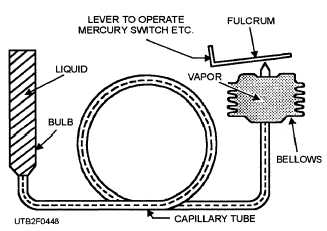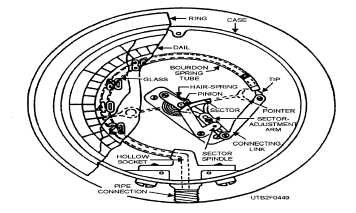
Figure 4-48. - Schematic of a remote-bulb device.

Figure 4-49. - A typical Bourdon spring tube.
hollow, partially flattened, bent tube, called a Bourdon spring tube. The pressure inside this tube tends to straighten it, and in so doing, it moves the lever mechanism that turns the pointer. The pressure gauge measures the pressure in pounds per square inch (psi).
Humidity-responsive devices open or close solenoid or motorized valves, which control the flow of water or steam to humidifying equipment. The sensitive element, which actuates the motion in this device, consists of a group of human hairs. These hairs lengthen when the humidity is high and shorten when the humidity is low.
Accumulation of dust and grease on these hairs, while not damaging, may decrease the sensitivity of the controller. Consequently, the element should be cleaned periodically with a camel's-hair brush and clean ether. A complete wetting with distilled water should follow this cleaning.
Electrical Switches. - Electrical switches in heating control equipment operate electrical circuits in response to signals from automatic control units. In other words, the actions initiated by devices responsive to temperature, pressure, and humidity changes open or close switch contacts. These, in turn, control the operation of the heating plant through electrical circuits. Switches may be either the snap-action type or the mercury type.
Snap-action switches vary in their designs.-Some are constructed so they have an over-center spring arrangement that is designed so the movement of the actuating lever engages the spring and causes the switch to move with snap-action. The snap-action type of switch is shown in figure 4-50, view A.
Another snap-action switch shown in figure 4-50, view A, has a small magnet that causes the electrical contacts to remain firmly closed. It also provides the switch with the snap-action effect. The contacts of this switch must open or close quickly to avoid excessive arcing across the points. Arcing burns the contacting surfaces, which eventually causes switch failure.
A mercury switch has the electrical contacts and a small amount of mercury in a hermetically sealed short glass tube, as shown in figure 4-50, view B. Tilting the switch causes the mercury inside the tube to cover or uncover the contacts. When the contacts are covered, the electrical circuit is completed.
Every electrical switch is designed so it has a specific rated capacity in amperes and volts; for example, a capacity of 8 amperes at 110 volts. An electrical switch should never be overloaded because overloading causes overheating, which eventually results in switch failure that can create a fire hazard.
The standard controls furnished for automatic fuel-burning equipment come in sets designed for warm-air, hot-water, and steam-heating systems. A standard set usually consists of a thermostat, limit control, primary control, and electric motor. Auxiliary controls are those designed for a specific function in a warm-air, hot-water, or steam-heating system. They are in addition to the standard controls.
Thermostat. - The thermostat is the nerve center of the heating-control system. It is the sensitive unit that responds to changes in room temperature. It indicates whether more or less heat is required from the
Continue Reading